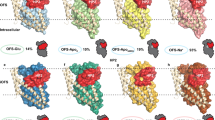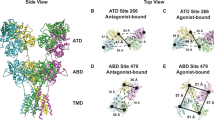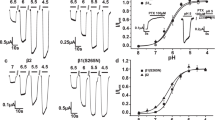Abstract
Kainic acid, a dicarboxylic acid containing pyrrolidine, is a potent neuronal depolarizing agent in the mammalian central nervous system, being some 50 times more effective than the putative neurotransmitter L-glutamate1–5. As kainic acid is a structural analogue of glutamic acid, it has been proposed that the potent excitatory effects of kainate reflect its restricted conformation, which is optimal for interaction with excitatory glutamate receptors2,4. More recent studies, however, do not support this hypothesis. In invertebrates kainic acid has been found to be a rather weak agonist at excitatory glutamate receptor sites6,7, whereas at the crustacean neuromuscular junction8, on certain neurones of Helix aspersa9 and in the mammalian cerebral cortex3, kainic acid seems to act at receptors distinct from those which mediate the neuroexcitatory action of glutamate. In addition, the ionic requirements for kainate-induced neuronal depolarization differ from those for glutamate-induced depolarization in the mammalian brain10, and glutamate-induced excitation of rat cortical neurones can be antagonized preferentially by drugs which are very weak in blocking kainate-induced depolarization11. Finally, the characteristics of binding sites for 3H-kainic acid in rat brain are consistent with the existence of specific kainate receptors on neuronal membranes12. Thus, the kainate sites may represent receptors for an unidentified endogenous substance probably containing the glutamate structure. Here we report that the pteroylmonoglutamate compound methyltetrahydrofolate (MTHF) is a potent competitor for 3H-kainic acid binding sites in rat cerebellar membranes. This action is specific in that MTHF is very weak or inactive at sites for 3H-glutamate or 3H-γ-aminobutyric acid (GABA) respectively. Electrophysio-logical studies in frog spinal cord suggest that MTHF is an agonist at the kainate receptors. The implications of these results are discussed.
This is a preview of subscription content, access via your institution
Access options
Subscribe to this journal
Receive 51 print issues and online access
$199.00 per year
only $3.90 per issue
Buy this article
- Purchase on Springer Link
- Instant access to full article PDF
Prices may be subject to local taxes which are calculated during checkout
Similar content being viewed by others
References
Shinozaki, H. & Konishi, S. Brain Res. 24, 368–371 (1970).
Johnston, G. A. R., Curtis, D. R., Davies, J. & McCulloch, R. M. Nature 248, 804–805 (1974).
McCulloch, R. M., Johnson, G. A., Game, C. J. & Curtis, D. R. Expl Brain Res. 21 515–518 (1974).
Buu, N. T., Puil, E. & van Gelder, N. M. Gen Pharmac. 7, 5–14 (1976).
Polc, P. & Haefely, W. Naunyn-Schmiedebergs Archs Pharmak. 300, 199–203 (1977).
Constanti, A. & Nistri, A. Br. J. Pharmac. 57, 359–368 (1976).
Clements, A. N. & May, T. E. J. exp. Biol. 61, 421–422 (1974).
Shinozaki, H. & Shibuya, I. Neuropharmacology 13, 1057–1065 (1974).
Walker, R. J. Comp. Biochem. Physiol. 55c, 61–67 (1976).
Evans, R. H., Francis, A. A. & Watkins, J. C. Experientia 33, 246–248 (1977).
Hall, J. G., Hicks, T. P. & McLennan, H. Neurosci. Lett. 8, 171–175 (1978).
London, E. D. & Coyle, J. T. Molec. Pharmac. 15, 492–505 (1979).
Enna, S. J. & Snyder, S. H. Brain Res. 100, 81–97 (1975).
Herbert, V., Larrabee, A. R. & Buchanan, J. M. J. clin. Invest. 41, 1134–1138 (1962).
Herbert, V. & Zalusky, R. Fedn Proc. 20, 453 (1961).
Spector, R. & Lorenzo, A. V. Science 187, 540–542 (1975).
Bridgers, W. F. & McClain, L. D. Adv. Biochem. Psychopharmac. 4, 81–92 (1972).
Loots, J. M. et al. (in preparation).
Lowagie, C. & Gerschenfeld, H. M. Nature 248, 533–535 (1974).
Spector, R. G. Biochem. Pharmac. 20, 1730–1732 (1971).
Hommes, O. R. & Obbens, E. A. M. T. J. neurol. Sci. 16, 271–281 (1972).
Olney, J. W., Sharp, L. G. & de Hubareff, T. Neurosci. Abstr. 5, 371 (1975).
Coyle, J. T. & Schwarcz, R. Nature 263, 244–246 (1976).
Herndon, R. M. & Coyle, J. T. Science 198, 71–72 (1977).
Coyle, J. T., Molliver, M. E. & Kuhar, M. J. J. comp. Neurol. 180, 301–323 (1978).
Curtis, D. R. et al. Brain Res. 41, 283–301 (1972).
Zieglgänsberger, W. & Puil, E. A. Expl Brain Res. 17, 35–49 (1973).
Schwarcz, R., Scholz, D. & Coyle, J. T. Neuropharmacology 17, 145–151 (1978).
Herbert, V. & Zalusky, R. J. clin. Invest. 41, 1263–1276 (1962).
van Tender, S., Metz, J. & Green, R. Br. J. Nutr. 34, 397–410 (1975).
Waters, A. H. & Mollin, D. L. Br. J. Haemat. 9, 319–327 (1963).
Brennan, M. J. W. et al. Brain Res. (in the press).
Baudry, M. & Lynch, G. Eur. J. Pharmac. 57, 283–285 (1979).
Author information
Authors and Affiliations
Rights and permissions
About this article
Cite this article
Ruck, A., Kramer, S., Metz, J. et al. Methyltetrahydrofolate is a potent and selective agonist for kainic acid receptors. Nature 287, 852–853 (1980). https://doi.org/10.1038/287852a0
Received:
Accepted:
Issue Date:
DOI: https://doi.org/10.1038/287852a0
This article is cited by
-
Methylfolate modulates potassium evoked neuro-secretion: Evidence for a role at the pteridine cofactor level of tyrosine 3-hydroxylase
Neurochemical Research (1995)
-
Modulation of potassium evoked secretory function in rat cerebellar slices measured by real time monitoring: Evidence of a possible role for methylfolate in cerebral tissue
Neurochemical Research (1993)
-
Congenital folate malabsorption
European Journal of Pediatrics (1985)
-
Recent advances in the use of selective neuron-destroying agents for neurobiological research
Experientia (1984)
-
Antagonism of the hypermotility response induced by excitatory amino acids in the rat nucleus accumbens
Naunyn-Schmiedeberg's Archives of Pharmacology (1984)
Comments
By submitting a comment you agree to abide by our Terms and Community Guidelines. If you find something abusive or that does not comply with our terms or guidelines please flag it as inappropriate.



